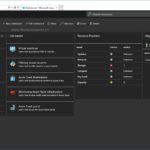A couple of weeks ago at the Microsoft Build Conference, Microsoft released some new information about what is coming in the next version of Windows Server like Linux support on Hyper-V Container and much more. Today Microsoft just announced some new details about the next Windows Server releases and how they will work. The biggest change of todays announcement that Windows Server and System Center will also move to the Semi-annual Channel, just like Windows Client and Office moved to the Semi-annual Channel release cycle. The other large announcement is that Microsoft focuses Nano Server on Container and will remove support Nano on Hosts and Virtual Machines. This means you can run Nano Server only as a Windows or Hyper-V Container.
Nano Server is only supported as a Container Image
Microsoft is removing support for the Nano Server operating system running on physical hardware or inside Virtual Machines. Nano Server will be only supported as a Container Image. Windows Server Core will be the preferred installation option for your infrastructure servers like Hyper-V or Storage Spaces Direct.
This next release will focus on making Nano Server the very best container image possible. From these changes, customers will now see the Nano Server images shrink in size by more than 50 percent, further decreasing startup times and improving container density. As part of this effort to focus on containers, we will be removing the functionality for infrastructure-related roles. Instead of using Nano Server for these scenarios, we recommend deploying the Server Core installation option, which includes all the roles and features you would need.
Windows Server Servicing Channel
As mentioned Microsoft will offer Windows Server updates in the Semi-annual Channel as well as in the Long Term Servicing Channel for Nano Server Container Images as well as Windows Server Core.
There will be two primary release channels available to Windows Server customers, the Long-term Servicing Channel, and the new Semi-annual Channel.
Long-term Servicing Channel
The Long-term Servicing Channel is the release model you’re already familiar with (currently called the “Long-term Servicing Branch”) where a new major version of Windows Server is released every 2-3 years. Users are entitled to 5 years of mainstream support, 5 years of extended support, and optionally 6 more years with Premium Assurance. This channel is appropriate for systems that require a longer servicing option and functional stability. Deployments of Windows Server 2016 and earlier versions of Windows Server will not be affected by the new Semi-annual Channel releases. The Long-term Servicing Channel will continue to receive security and non-security updates, but it will not receive the new features and functionality.
Semi-annual Channel
The Semi-annual Channel releases will deliver new functionality for customers who are moving at a “cloud cadence,” such as those on rapid development cycles or hosters keeping up with the latest Hyper-V investments. Windows Server products in the Semi-annual Channel will have new releases available twice a year, in spring and fall. Each release in this channel will be supported for 18 months from the initial release.
Most of the features introduced in the Semi-annual Channel will be rolled up into the next Long-term Servicing Channel release of Windows Server. The editions, functionality, and supporting content might vary from release to release depending on customer feedback.
The Semi-annual Channel will be available to volume-licensed customers with Software Assurance, as well as via the Azure Marketplace or other cloud/hosting service providers and loyalty programs such as MSDN.
Windows Insider Program
At Microsoft Build, Microsoft also announced that Windows Server will be part of the Windows Insider Program, and you will see the first preview builds this summer.
System Center
in the first Semi-annual Channel release from System Center, the team will focus on System Center Operations Manager, Virtual Machine Manager, and Data Protection Manager. The key areas of investment will include support for Windows Server and Linux, enhanced performance, usability and reliability, and extensibility with Azure-based security and management services. Which will bring features like Nested Virtualization support, software load balancing, Storage QoS Self-Service and management support for heterogeneous environments with improved Linux monitoring using a FluentD agent as well as VMware backup. System Center Configuration Manager will continue to offer three releases a year to give you the latest updates for managing servers, PCs, and mobile devices.
Conclusion
This changes will improve the release cadence of datacenter and cloud innovation dramatically. Customers like service providers will have the chance to update their offerings much more often which allows them to add new features and functionality. But there is choice for customers who need a stable and not fast moving environment they can deploy builds from the Long-term servicing channel, which will have long term support. With that you should be able to choose the best solution for your environment and workload.
Tags: Branch, Container, Hyper-V, Linux, Long-term Servicing Channel, LTSB, LTSC, Microsoft, Nano Server, SAC, Semi-annual Channel, System Center, System Center 2016, vNext, Windows Insider, Windows Insider Program, Windows Insider Program for Windows Server, Windows Server, Windows Server 2016 Last modified: November 1, 2018












Hi Thomas,
Any word on how that works out ?
We’ve got an RDS-Farm of 4 servers, from which I understood, as soon as you make it an RDS-Server, it becomes LTSB, regardless. If we would upgrade them to 1709, do they then become Semi-Annual Channel all of a sudden, or would they be v1709 but remain LTSB ?
I cannot read anything about this anywhere…
All Installations of Windows Server 2016 (Expect for Nano Server) stay in LTSC (former LTSB).
Semi-Annual Channel is a reinstall. Since 1709 is Core Server only, there is no upgrade for RDS Servers.
Does this answer your question? :)
Yes, thank you. Didn’t know 1709 is core only !
Is there a free Hyper-V Server 1709?